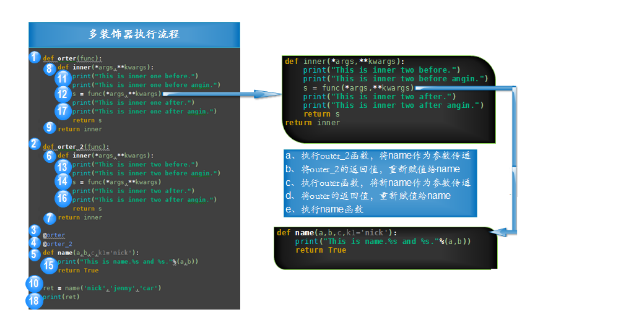python修炼7----迭代器
一、装饰器
1.定义
本质就是函数,功能 为其它函数添加附加功能
原则:
- 不修改被修饰函数的源代码
- 不修改被修饰函数的调用方式
装饰器的知识储备
装饰器 = 高阶函数+函数嵌套+闭包
这里面要明确高阶函数的定义
import time#导入时间模块儿
def foo(func): # func = test
def bar(*args,**kwargs):
start_time = time.time()
res=func(*args,**kwargs) # 这里就是在运行test() 赋予变量
stop_time = time.time()
print("狼来了的时间为%s" %(stop_time-start_time))
return res # 返回test()的值
return bar
@foo # @foo 相当于 test=foo(test) 调用foo函数并将test传给func
def test(name,age):
time.sleep()
print("名字叫%s年龄为%s的狼来了" %(name,age))
return "村里的羊被吃了"
ret = test("灰太狼",age=) # test()意在运行bar() # 输出res的返回值
print(ret) 装饰器模型
装饰器模型
装饰器是一个很著名的设计模式,经常被用于有切面需求的场景,较为经典的有插入日志、性能测试、事务处理等。装饰器是解决这类问题的绝佳设计,有了装饰器,我们就可以抽离出大量函数中与函数功能本身无关的雷同代码并继续重用。概括的讲,装饰器的作用就是为已经存在的对象添加额外的功能。
先定义一个基本的装饰器:
########## 基本装饰器 ##########
def orter(func): #定义装饰器
def inner():
print("This is inner before.")
s = func() #调用原传入参数函数执行
print("This is inner after.")
return s #return原函数返回值
return inner #将inner函数return给name函数 @orter #调用装饰器(将函数name当参数传入orter装饰器)
def name():
print("This is name.")
return True #name原函数return True ret = name()
print(ret) 输出结果:
This is inner before.
This is name.
This is inner after.
True
1.给装饰器传参数:
############ 装饰器传参数 ###########
def orter(func):
def inner(a,b): #接收传入的2个参数
print("This is inner before.")
s = func(a,b) #接收传入的原函数2个参数
print("This is inner after.")
return s
return inner @orter
def name(a,b): #接收传入的2个参数,并name整体函数当参数传入orter装饰器
print("This is name.%s,%s"%(a,b))
return True ret = name('nick','jenny') #传入2个参数
print(ret) 输出结果:
This is inner before.
This is name.nick,jenny
This is inner after.
True
给装饰器传万能参数:
########## 万能参数装饰器 ##########
def orter(func):
def inner(*args,**kwargs): #万能参数接收多个参数
print("This is inner before.")
s = func(*args,**kwargs) #万能参数接收多个参数
print("This is inner after.")
return s
return inner @orter
def name(a,b,c,k1='nick'): #接受传入的多个参数
print("This is name.%s,%s"%(a,b))
return True ret = name('nick','jenny','car')
print(ret) 输出结果:
This is inner before.
This is name.nick,jenny
This is inner after.
True
2.一个函数应用多个装饰器方法:
########### 一个函数应用多个装饰器 ######### def orter(func):
def inner(*args,**kwargs):
print("This is inner one before.")
print("This is inner one before angin.")
s = func(*args,**kwargs)
print("This is inner one after.")
print("This is inner one after angin.")
return s
return inner
def orter_2(func):
def inner(*args,**kwargs):
print("This is inner two before.")
print("This is inner two before angin.")
s = func(*args,**kwargs)
print("This is inner two after.")
print("This is inner two after angin.")
return s
return inner
@orter #将以下函数整体当参数传入orter装饰器
@orter_2 #将以下函数当参数传入orter_2装饰器
def name(a,b,c,k1='nick'):
print("This is name.%s and %s."%(a,b))
return True ret = name('nick','jenny','car')
print(ret) 输出结果:
This is inner one before.
This is inner one before angin.
This is inner two before.
This is inner two before angin.
This is name.nick and jenny.
This is inner two after.
This is inner two after angin.
This is inner one after.
This is inner one after angin.
True

3.闭包
'''
闭包:在一个作用域里放入定义变量,相当于打了一个包
'''
def father(name):
def son():
# name='alex'
print('我爸爸是 [%s]' %name)
def grandson():
# name='wupeiqi'
print('我爷爷是 [%s]' %name)
grandson()
son()
father('舒克')
4.综合运用
user_list=[
{'name':'alex','passwd':''},
{'name':'linhaifeng','passwd':''},
{'name':'wupeiqi','passwd':''},
{'name':'yuanhao','passwd':''},
{'name':'病毒尖er','passwd':''},
]
current_user={'username':None,'login':False} def auth_func(func): # 用户登陆验证
def bar(*args,**kwargs):
if current_user["username"] and current_user["login"]:
res = func(*args,**kwargs)
return res
for i in range():
username = input("请输入用户名:").strip()
passwd = input("请输入密码:").strip()
for item in user_list:
if username == item["name"] and passwd == item["passwd"]:
current_user["username"] = username
current_user["login"] = True
res=func(*args,**kwargs)
return res
else:
print("您输入的用户名或者密码有误")
return bar
@auth_func # 相当于index=auth_func(index)
def index():
print("欢迎来到京东商城" )
@auth_func # 相当于home=auth_func(home)
def home(name):
print("%s欢迎回家" %name)
@auth_func # 相当于shop_car=auth_func()
def shop_car(name):
print("%s的购物车是空的,赶紧购物咯" %name) index()
home(current_user["username"])
shop_car(current_user["username"])
user_list=[
{'name':'alex','passwd':''},
{'name':'linhaifeng','passwd':''},
{'name':'wupeiqi','passwd':''},
{'name':'yuanhao','passwd':''},
{'name':'病毒尖er','passwd':''},
]
current_user={'username':None,'login':False}
def auth(auth_type="file"):
def auth_func(func): # 用户登陆验证
def bar(*args,**kwargs):
if auth_type == "file":
if current_user["username"] and current_user["login"]:
res = func(*args,**kwargs)
return res
for i in range(): # 给用户三次重复输入的机会 防止进入其它功能进入下一层
username = input("请输入用户名:").strip()
passwd = input("请输入密码:").strip()
for item in user_list:
if username == item["name"] and passwd == item["passwd"]:
current_user["username"] = username
current_user["login"] = True
res=func(*args,**kwargs)
return res
else:
print("您输入的用户名或者密码有误")
elif auth_type == "ldap":
print("快点告诉你,你用我画的蜡笔")
res = func(*args,**kwargs)
return res
return bar
return auth_func
@auth(auth_type="file")
def index():
print("欢迎来到京东商城" )
@auth(auth_type="ldap") # 传参数 类型对应
def home(name):
print("%s欢迎回家" %name)
@auth(auth_type="file")
def shop_car(name):
print("%s的购物车是空的,赶紧购物咯" %name) index()
home(current_user["username"])
shop_car(current_user["username"]) 有参装饰器
二、代器 & 生成器
1、迭代器
迭代器只不过是一个实现迭代器协议的容器对象。
迭代器协议是指:对象必须提供一个next方法,执行该方法要么返回迭代中的下一项,要么就引起一个StopIteration异常,以终止迭代 (只能往后走不能往前退)
特点:
- 访问者不需要关心迭代器内部的结构,仅需通过next()方法不断去取下一个内容
- 不能随机访问集合中的某个值 ,只能从头到尾依次访问
- 访问到一半时不能往回退
- 便于循环比较大的数据集合,节省内存
>>> a = iter([,,,,])
>>> a
<list_iterator object at 0x101402630>
>>> a.__next__() >>> a.__next__() >>> a.__next__() >>> a.__next__() >>> a.__next__() >>> a.__next__()
Traceback (most recent call last):
File "<stdin>", line 1, in <module>
StopIteration #末尾生成StopIteration异常
2.1、生成器
一个函数调用时返回一个迭代器,那这个函数就叫做生成器(generator);如果函数中包含yield语法,那这个函数就会变成生成器。
生成器的概念:自动实现了迭代器协议(其他的数据类型需要调用自己内置的__iter__方法),所以生成器就是可迭代对象
def xran():
print("one")
yield
print("two")
yield
print("sr")
yield ret = xran()
#print(ret) #<generator object xran at 0x00000000006ED308> result = ret.__next__()
print(result) result = ret.__next__()
print(result) result = ret.__next__()
print(result) # ret.__next__() #循环完毕抛出StopIteration
#
# ret.close() #关闭生成器
2.2.生成器表达式
>>>a=[,,]
>>>b=[i** for i in a]
>>>b
[, , ]
>>>ib=(i** for i in a)
>>>ib
<generator object <genexpr> at 0x7f72291217e0>
>>>next(ib) >>>next(ib) >>>next(ib) >>>next(ib)
Traceback (most recent call last):
File "<stdin>", line , in <module>
StopIteration
2.4补充1
# 用生成器函数
# yield 相当于return控制的是函数的返回值
# x=yield的另外一个特性,接收send传过来的值,赋值给x
def test():
print("开始啦")
first = yield # return first = None
print("第一次",first)
yield
print("第二次")
t = test()
print(test().__next__())
res = t.__next__() # next(t)
print(res)
res = t.send("函数停留在first那个位置,我就是给first赋值的")
print(res) 输出结果
开始啦
None
开始啦
None
第一次 函数停留在first那个位置,我就是给first赋值的
2.5补充于总结
1.yield--->自定义函数中只要出现y写了点就说明函数已经是一个Generator。
- yield--->m=yield 5 131 可作为表达式进行赋值,此刻m的值是131,5是def定义的函数返回的值
- yield--->next() 函数被调用后必须经过.__next__()方法执行,直到返回值StopIteration停止
2.send()与next()
- send()与next()作用基本相同,但是send(*)可以产地yield的表达式值进入,而next()不能传递特定的值,只能传递None进去
- 友情提醒:第一次调用时,请使用next()语句或是send(None),不能使用send发送一个非None的值,否则会出错的,因为没有yield语句来接收这个值
3.总结
优点:生成器使用yield语句返回一个值。yield语句挂起该生成器函数的状态,保留足够的信息,以便之后从它离开的地方继续执行
优点一:生成器的好处是延迟计算,一次返回一个结果。也就是说,它不会一次生成所有的结果,这对于大数据量处理,将会非常有用。
优点二:生成器还能有效提高代码可读性
注意事项:生成器只能遍历一次(母鸡一生只能下一定数量的蛋,下完了就死掉了)
四、python'中 for循环机制
1.首先通过调用.__iter__()方法把他们变成可迭代对象
2.之后for循环调用了__next__方法进行取值
3.for循环会捕捉StopIteration异常,以终止迭代
返回:基础之函数
python修炼7----迭代器的更多相关文章
- Python基础之迭代器和生成器
阅读目录 楔子 python中的for循环 可迭代协议 迭代器协议 为什么要有for循环 初识生成器 生成器函数 列表推导式和生成器表达式 本章小结 生成器相关的面试题 返回顶部 楔子 假如我现在有一 ...
- python修炼第一天
Python修炼第一天 新的开始:不会Python的运维,人生是不完整的. 为了我的人生能够完整,所以我来了!今后跟着太白金星师傅学习功夫,记录一下心得,以便日后苦练. 一 Python的历史: Py ...
- python is、==区别;with;gil;python中tuple和list的区别;Python 中的迭代器、生成器、装饰器
1. is 比较的是两个实例对象是不是完全相同,它们是不是同一个对象,占用的内存地址是否相同 == 比较的是两个对象的内容是否相等 2. with语句时用于对try except finally 的优 ...
- python基础之迭代器协议和生成器
迭代器和生成器补充:http://www.cnblogs.com/luchuangao/p/6847081.html 一 递归和迭代 略 二 什么是迭代器协议 1.迭代器协议是指:对象必须提供一个ne ...
- python设计模式之迭代器与生成器详解(五)
前言 迭代器是设计模式中的一种行为模式,它提供一种方法顺序访问一个聚合对象中各个元素, 而又不需暴露该对象的内部表示.python提倡使用生成器,生成器也是迭代器的一种. 系列文章 python设计模 ...
- Python之路迭代器协议、for循环机制、三元运算、列表解析式、生成器
Python之路迭代器协议.for循环机制.三元运算.列表解析式.生成器 一.迭代器协议 a迭代的含义 迭代器即迭代的工具,那什么是迭代呢? #迭代是一个重复的过程,每次重复即一次迭代,并且每次迭代的 ...
- python基础8 -----迭代器和生成器
迭代器和生成器 一.迭代器 1.迭代器协议指的是对象必须提供一个next方法,执行该方法要么返回迭代中的下一项,要么就引起一个StopIteration异常,以终止迭代 (只能往后走不能往前退) 2. ...
- Python 拓展之迭代器
写在之前 今天来讲讲「迭代器」的内容,其实已经拖了好多天了,感觉再不写就要忘记了.「迭代」相信对你来说已经不陌生了,我前面曾经专门用一篇文章来讲,如果你已经没有什么印象的话,就再点进去看看(零基础学习 ...
- 【Python基础】迭代器、生成器
迭代器和生成器 迭代器 一 .迭代的概念 #迭代器即迭代的工具,那什么是迭代呢? #迭代是一个重复的过程,每次重复即一次迭代,并且每次迭代的结果都是下一次迭代的初始值 while True: #只是单 ...
- Python - 三大器 迭代器,生层器,装饰器
目录 Python - 三大器 迭代器,生层器,装饰器 一. 容器 二. 可迭代对象(iterable) 三. 迭代器 四. 生成器 五. 装饰器 1. 定义 六. 闭包 Python - 三大器 迭 ...
随机推荐
- IOS开发的内存管理
关于IOS开发的内存管理的文章已经很多了,因此系统的知识点就不写了,这里我写点平时工作遇到的疑问以及解答做个总结吧,相信也会有人遇到相同的疑问呢,欢迎学习IOS的朋友请加ios技术交流群:190956 ...
- 单例模式及C++实现代码
单例模式及C++实现代码 单例模式 单例模式,可以说设计模式中最常应用的一种模式了,据说也是面试官最喜欢的题目.但是如果没有学过设计模式的人,可能不会想到要去应用单例模式,面对单例模式适用的情况,可能 ...
- gettimeofday(struct timeval *tv, struct timezone *tz)函数
gettimeofday(struct timeval *tv, struct timezone *tz)函数 功能:获取当前精确时间(Unix时间) 其中: timeval为时间 truct tim ...
- Ubuntu系统中初次下载Android源码的一点经验
这阵子突然心血来潮,想看看android的源代码,所以这一两天晚上都在折腾下载这个东西. (其实在GitHub上可以在线看的,不过不太喜欢在线看,URL附上 https://github.com/an ...
- 微信公众号开发之网页中及时获取当前用户Openid及注意事项
目录 (一)微信公众号开发之VS远程调试 (二)微信公众号开发之基础梳理 (三)微信公众号开发之自动消息回复和自定义菜单 (四)微信公众号开发之网页授权获取用户基本信息 (五)微信公众号开发之网页中及 ...
- SASS使用CSS3动画并使动画暂停和停止在最后一帧的简单例子
今天在手机上试了试这个 css3 动画效果,可以把动画效果停留在最后一帧上,以及鼠标 :hover 暂停动画,比较实用的功能,不用 JS 也能实现这些效果了. 不过测试体验感觉手机上没有 jQuery ...
- PostScript学习:另一种缩写为PS的技术
1.前言 PostScript是一种编程语言,直译为"后处理脚本"[相对印刷过程而言],学名为页面描述语言.更为详细的解释见维基百科,以及其翻译版百度百科. 值得一提的是,Post ...
- USACO 4.1 Beef McNuggets
Beef McNuggetsHubert Chen Farmer Brown's cows are up in arms, having heard that McDonalds is conside ...
- PostgreSQL Replication之扩展与BDR
在这一章中,将向您介绍一个全新的技术,成为BDR.双向复制(BDR),在PostgreSQL的世界里,它绝对是一颗冉冉升起的新星.在不久的将来,许多新的东西将会被看到,并且人们可以期待一个蓬勃发展的项 ...
- Vim快捷键大全
vi(vim)是上Linux非常常用的编辑器,很多Linux发行版都默认安装了vi(vim).vi(vim)命令繁多但是如果使用灵活之后将会大大提高效率.vi是"visual interfa ...
